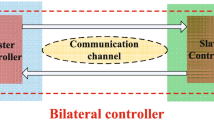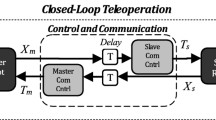Abstract
In the presence of communication latency in a bilateral teleoperation system, stability and transparency are highly regarded. The major problem with teleoperation systems is complex dynamic and subsequently designing the controller. This essay presents a novel method of controller design, based on singular perturbation framework for the bilateral teleoperation of nonlinear robots through the Internet. Using this method makes it much easier to design the controller because controller designing is done for reduced-order subsystem not full-order system. In this paper, teleoperation system dynamics was decomposed into slave (slow subsystem) and error (fast subsystem, different from master and slave), which contains position and velocity, and an adaptive sliding mode controller was designed for each of them. For constant and time-varying delay, the positions of master–slave were compared together and controlling signal was applied to the slave; therefore, they could track each other in the shortest possible time. In the simulation, the stability and performance results of teleoperation system were obtained under the proposed controller and compared with those of another approach. In this research, having higher speed and lower control signal amplitude, at the same time, elucidates the absolute superiority of the new approach.



















Similar content being viewed by others
References
Micaelli, A., Marchal, P., Vertut, J.: Short transmission delay on a force reflective bilateral manipulator. In: Proceeding 4th Rom_An, Sywarsaw, pp. 269–275 (1981)
Trevelyan, J.: Simplifying robotics—a challenge for research. Rob. Auton. Syst. 21(3), 207–220 (1997)
Suomela, J., Savela, M., Halme, A.: Applying telepresence and augmented reality to teleoperate field robots. Rob. Auton. Syst. 26(2–3), 117–125 (1999)
Bapna, D., Maimone, M., Thomas, G., Wettergreen, D.: Developing Nomad for robotic exploration of the Atacama Desert. Rob. Auton. Syst. 26(2–3), 127–148 (1999)
Shiose, T., Akashi, G., Sawaragi, T.: Foundations for designing an ecological interface for mobile robot teleoperation. Rob. Auton. Syst. 31(3), 193–207 (2000)
Kwon, D.-S., Hannaford, B., Ryu, J.-H.: Stable teleoperation with time-domain passivity control. IEEE Trans. Rob. Autom. 20(2), 365–373 (2004)
Lewis, F.L., Huang, J.Q.: Neural network predictive control for nonlinear dynamicm systems with time-delay. IEEE Trans. Neural Netw. 14(2), 377–389 (2003)
Liu, J.N.K., Wang, M.: Interactive control for Internet-based mobile robot teleoperation. Rob. Auton. Syst. 52(2–3), 160–179 (2005)
Postigo, J.F., Mut, V., Slawiñski, E.: Bilateral teleoperation through the Internet. Rob. Auton. Syst. 55(3), 205–215 (2007)
Ferreira, A., Boukhnifer, M.: Wave-based passive control for transparent micro-teleoperation system. Rob. Auton. Syst. 54(7), 601–615 (2006)
Parra-Vega, V., Arteaga, M.A., García-Valdovinos, L.-G.: Observer-based sliding mode impedance control of bilateral teleoperation under constant unknown time delay. Rob. Auton. Syst. 55(8), 609–617 (2007)
Chernova, S., Veloso, M., Browning, B., Argall, B.D.: A survey of robot learning from demonstration. Rob. Auton. Syst. 57(5), 469–483 (2009)
Momeni, H., Janabi-Sharifi, F., Hosseini-Suny, K.: A modified adaptive controller design for teleoperation systems. Rob. Auton. Syst. 58(5), 676–683 (2010)
Seo, Ch., Kim, Jong-Phil, Ryu, J., Park, S.: Robustly stable rate-mode bilateral teleoperation using an energy-bounding approach. Mechatronics 21, 176–184 (2011)
Talebi, H.A., Sedigh, A.K., Forouzantabar, A.: Adaptive neural network control of bilateral teleoperation with constant time delay. Nonlinear Dyn. 67(2), 1123–1134 (2012)
Ding, H., Fei, J.: Adaptive sliding mode control of dynamic system using RBF neural network. Nonlinear Dyn. 70(2), 1563–1573 (2012)
Sirouspour, S., Shahdi, A.: Adaptive control of bilateral teleoperation with time delay. Int. J. Intell. Mechatron. Robot. 2(1), 1–27 (2012)
Abbink, D.A., Boessenkool, H., Heemskerk, C.J.M., Koning, J.F., Wildenbeest, J.G.W.: How operator admittance affects the response of a teleoperation system to assistive forces—a model analytic study and simulation. Fusion Eng. Des. 88(9–10), 2001–2005 (2013)
Azorin, J.M., Ferre, M., Peña, C., Aracil, R.: Bilateral control by state convergence based on transparency for systems with time delay. Rob. Auton. Syst. 61(2), 86–94 (2013)
Liu, P.X., El Saddik, A., Islam, S.: Nonlinear control for teleoperation systems with time varying delay. Nonlinear Dyn. 76(2), 931–954 (2014)
Alfi, A., Shokri-Ghaleh, H.: Optimal synchronization of teleoperation systems via cuckoo optimization algorithm. Nonlinear Dyn. 78(4), 2359–2376 (2014)
Khalil, H., O’Reilly, J., Kokotovic, P.: Singular Perturbation Methods in Control Analysis and Design. Society for Industrial and Applied Mathematics, Philadelphia (1999)
Fenichel, N.: Geometric singular perturbation theory for ordinary differential equations. J. Differ. Equ. 31, 53–98 (1979)
Moehlis, J.: Canards for a reduction of the Hodgkin–Huxley equations. J. Math. Biol. 52(2), 141–153 (2006)
Rubin, W.M., Rubin, J., Wechselberger, M.: Giant squid-hidden canard: the 3D geometry of the Hodgkin–Huxley model. Biol. Cybern. 97(1), 5–32 (2007)
Hek, G.: Geometric singular perturbation theory in biological practice. J. Math. Biol. 60, 347–386 (2010)
Siddarth, A., Valasek, J.: Global tracking control structures for nonlinear singularly perturbed aircraft systems. In: Proceedings of the CEAS EuroGNC, pp. 13–15 (2011)
Ricardo, P., Marco, D.S., Teixeira, A.: Regularization and singular perturbation techniques for non-smooth systems. Phys. D 241(22), 1948–1955 (2012)
Sheridan, T.B.: Telerobotics, Automation, and Human Supervisory Control. The MIT Press, Cambrige (1992)
Lee, D., Spong, M.W.: Passive bilateral teleoperation with constant time delay. In: IEEE Robotics and Automation Society, vol. 22, no. 2, pp. 269–281 (2006)
Craig, J.J.: Introduction to Robotics Mechanics and Control, 2nd edn. (1989)
Janabi-Sharifi, F.: Collision: modelling, simulation and identification of robotic manipulators interacting with environments. J. Intell. Robot. Syst. 13, 1–44 (1995)
Pinto, M.A., Trofimchuk, S.I., Ivanov, A.F.: Global behavior in nonlinear system with delayed feedback. In: IEEE Conference on Decision and Control, Sydney, Australia, pp. 4420–4421 (2000)
Ivanov, A. F., Sharkovsky, A.N.: Oscillations in singularly perturbed delay equations. Dynamics reported, pp. 165–224 (1991)
Reinoso, O., Sabater, J. M., Perez, C., Azorin, J. M.: A new control method of teleoperation with time delay. In: The International Conference on Advanced Robotics Coimbra, Portugal, pp. 100–105 (2003)
Author information
Authors and Affiliations
Corresponding author
Appendix
Appendix
Proof: According to the Eq. (37) for the slow subsystem, we have:
We can rewrite the above equation in this form:
After simplification, we have:
Equilibrium point for above system is \(\left( \frac{BB_{Fs2}}{a_s k_s},0\right) \) and we must transfer it to origin; hence, we utilize a new variable to solve this problematic trouble. Therefore,
Now, we suggest following Lyapunov function for the slow subsystem with this new variable:
Now:
We choose:
After simplification, we have:
Therefore,
After substitution, we have:
Now, we continue proof for the fast subsystem. By using Eq. (38), we have:
After rewriting the Eq. (64), we obtain:
After simplification, we reach:
Equilibrium point for above system is in origin (0,0); therefore, we offer the following Lyapunov function for the fast subsystem:
Now:
We choose:
After simplification, we have:
Therefore,
Rights and permissions
About this article
Cite this article
Ganjefar, S., Sarajchi, M.H. & Hamidi Beheshti, M.T. Adaptive sliding mode controller design for nonlinear teleoperation systems using singular perturbation method. Nonlinear Dyn 81, 1435–1452 (2015). https://doi.org/10.1007/s11071-015-2078-1
Received:
Accepted:
Published:
Issue Date:
DOI: https://doi.org/10.1007/s11071-015-2078-1




